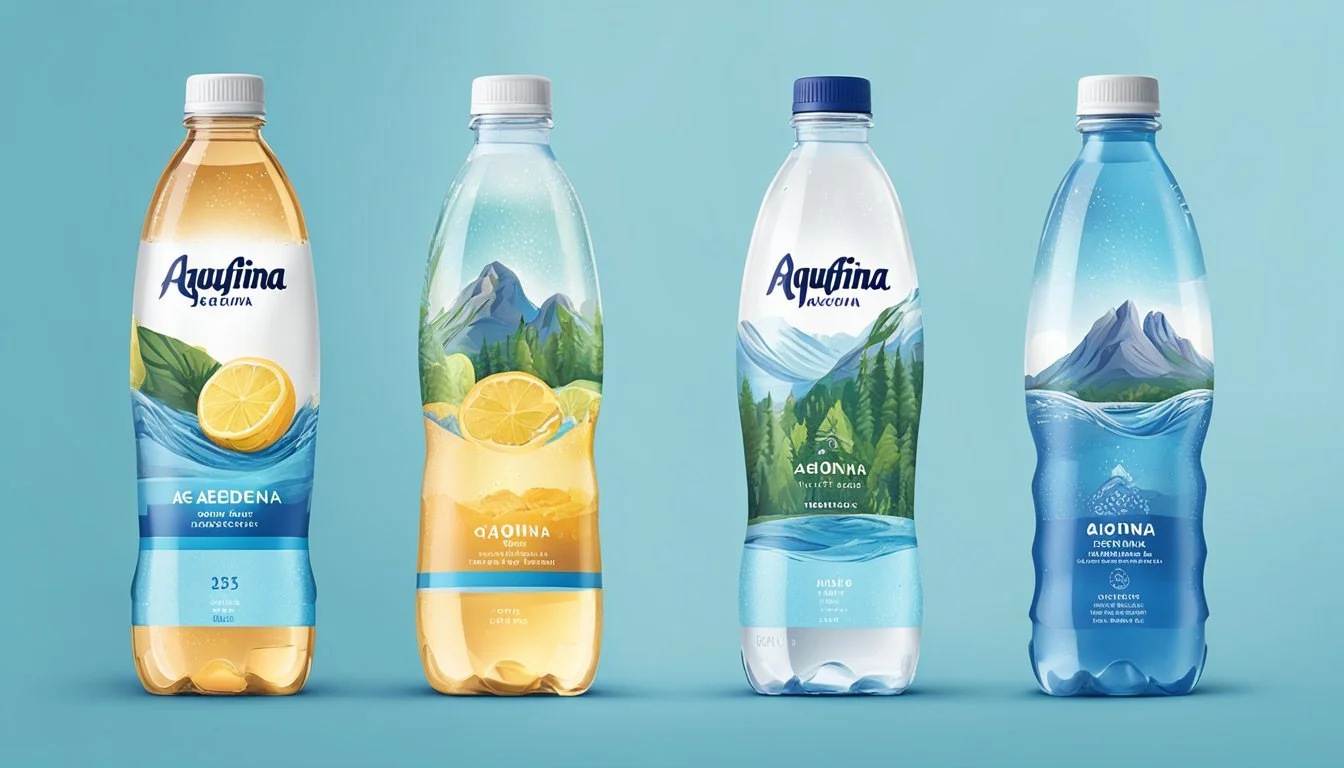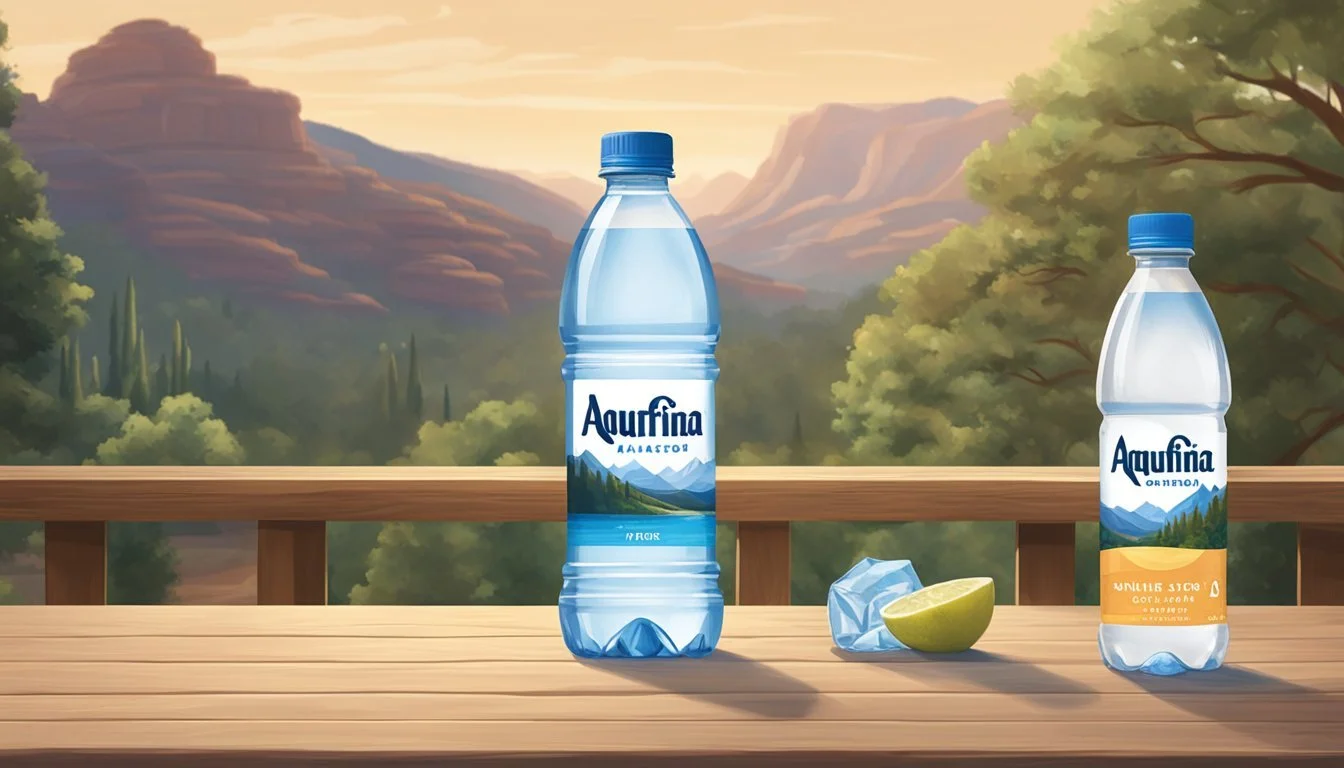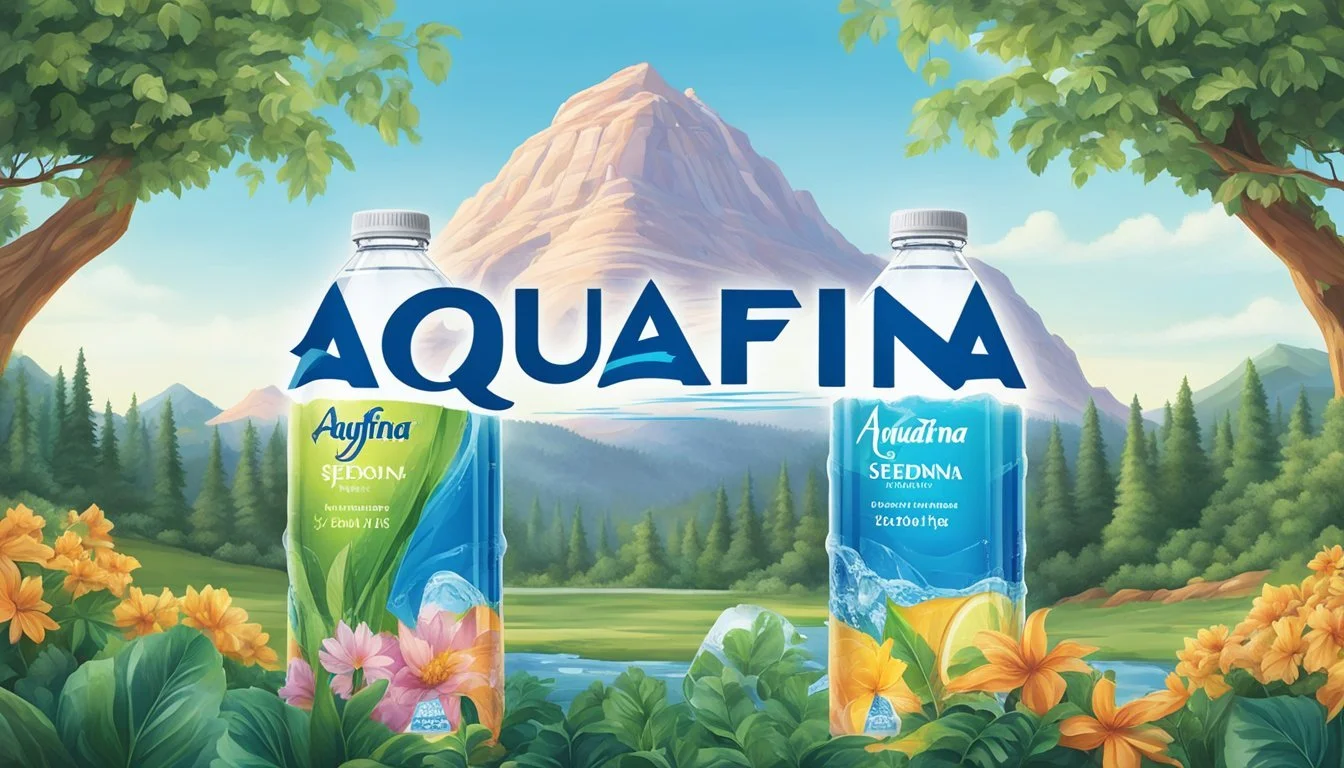Aquafina vs. Purely Sedona
An Expert Comparison of Bottled Waters
Consumers often find themselves standing in the bottled water aisle, wondering which brand to choose for their hydration needs. Aquafina, a well-known brand, boasts its rigorous HydRO-7 filtration process designed to purify the water by removing impurities. On the other hand, Purely Sedona prides itself on sourcing water directly from natural springs, promising a more untouched and natural taste.
For those who prioritize taste, Purely Sedona’s naturally sourced water offers a crisp and refreshing experience that might be preferable to some. Aquafina, with its enhanced purification process, guarantees a consistent and clean flavor, free from most additives. This comparison offers a straightforward look at the key aspects of each brand, helping readers choose based on their own preferences for purity, taste, and natural sourcing.
Exploring Bottled Water
Bottled water comes in various types, each differing in source, treatment, and mineral content. This diversity affects taste, health benefits, and environmental impact.
Defining Bottled Water
Bottled Water refers to water that is sealed in bottles for consumption. It can be distinguished from regular tap water by its source and the processes it undergoes before bottling. The source can include natural springs, artesian wells, or even municipal supplies.
To qualify as bottled water, it must meet specific safety and labeling standards set by authorities. Bottled water can be further classified based on its treatment and mineral additions, which can influence its taste and benefits.
Categories of Bottled Water
Bottled water can be categorized into several types based on its origin and treatment:
Natural Spring Water: Originates from an underground source and flows naturally to the surface. It's typically rich in minerals.
Purified Water: Comes from any source, but has been treated to remove chemicals and impurities. Methods include distillation and reverse osmosis.
Mineral Water: Contains a certain level of naturally occurring minerals and is usually sourced from springs or wells. The mineral content can affect flavor and health benefits.
Filtered Tap Water: Municipal tap water that has been treated to remove contaminants but may not involve extensive mineral addition.
Understanding the Bottling Process
The bottling process involves several key steps to ensure the safety and quality of the water:
Source Selection: Ensuring that the source (spring, municipal, etc.) meets strict regulatory standards.
Purification: This can involve reverse osmosis, where water is forced through a membrane to remove impurities, or distillation, which uses heat to vaporize and recondense water, leaving contaminants behind. Both methods produce purified water.
Mineral Addition: For some brands, minerals are added back to enhance flavor or nutritional content, creating mineral or spring water.
Bottling: The purified water is then bottled under hygienic conditions to prevent contamination.
These steps ensure the bottled water is safe to drink and often results in significant differences in taste, health benefits, and overall quality compared to tap water.
Brand Analysis
Aquafina and Purely Sedona differ significantly in their brand histories and the sources of their water, which are crucial aspects to consider when comparing these two bottled water brands.
Brand History and Origin
Aquafina, a product of PepsiCo, was introduced in 1994. It rapidly expanded to become one of the leading bottled water brands in the United States. Aquafina's popularity is largely due to its extensive availability and the branding power of PepsiCo.
Purely Sedona, on the other hand, is a more niche brand known for sourcing its water from natural springs. It emphasizes purity and natural origin, branding itself as an artisan water product. This focus on natural springs and high-quality sourcing differentiates it from mass-market competitors.
Source and Collection
Aquafina sources its water from municipal supplies. Using a rigorous 7-step HydRO-7 purification process, Aquafina ensures the removal of contaminants and adds minerals for taste. This process guarantees safety but does not originate from natural springs.
Purely Sedona sources its water from natural springs in Sedona, Arizona. The water undergoes minimal processing to maintain its natural mineral content. This source distinction provides a taste profile often appreciated by consumers seeking natural spring water.
Overall, the primary difference lies in Aquafina's use of municipal sources and extensive purification, compared to Purely Sedona's natural spring origins and minimal processing.
Quality and Composition
When comparing Aquafina and Purely Sedona, it is crucial to consider their mineral enhancement, pH levels, taste profile, electrolytes, and purity in removing contaminants. These factors directly impact the overall quality and hydration benefits offered by each brand.
Mineral Enhancement and PH Levels
Aquafina:
Aquafina is known for its rigorous HydRO-7 filtration process, which aims to remove a wide array of impurities. This extensive purification leads to a very low mineral content, creating a nearly neutral pH. Aquafina typically does not add minerals back into the water, leaving it with a pH level around 6.0-7.0, indicating slightly acidic to neutral water.
Purely Sedona:
Purely Sedona sources its water from natural artesian springs, rich in native minerals. This process helps maintain a balanced mineral content, contributing to a slightly alkaline pH. Most bottled under the name Purely Sedona boast pH levels around 7.8-8.2, providing alkalinity that enthusiasts believe can aid in reducing acidity in the body.
Taste Profile and Electrolytes
Aquafina:
Due to its nearly pure composition with minimal minerals, Aquafina has a very clean, crisp taste. However, some consumers might find it lacks character or feels "flat." Aquafina does not typically add electrolytes for taste, focusing instead on a pure water experience.
Purely Sedona:
Purely Sedona offers a taste that reflects its natural mineral content and slight alkalinity. The presence of minerals such as calcium and magnesium, as well as naturally occurring electrolytes, gives the water a more distinct and refreshing flavor. This makes it enjoyable and suitable for those seeking more than just hydration from their water.
Purity and Contaminant Removal
Aquafina:
Aquafina's HydRO-7 process is particularly effective at removing contaminants. This method encompasses seven specific stages, including reverse osmosis and carbon filtration, ensuring that impurities such as chlorine, heavy metals, and other contaminants are minimized or eliminated. The result is highly purified water that prioritizes safety and cleanliness.
Purely Sedona:
Purely Sedona takes pride in its natural sourcing from artesian springs. This water undergoes natural filtration through the earth, which can capture and neutralize various contaminants. Following this natural filtration, additional purification processes are applied to ensure the water remains free from harmful substances. The dual filtration approach helps retain beneficial minerals while ensuring purity.
Health and Hydration Benefits
When choosing between Aquafina and Purely Sedona, it's essential to consider how each brand's water benefits health and hydration. This section examines efficiency in hydration and the impact of mineral content on health.
Hydration Efficiency
Aquafina utilizes a 7-step HydRO-7 filtration process that ensures the water is thoroughly purified, removing a significant amount of dissolved solids and potential contaminants. This rigorous purification can lead to a clean taste and may aid in efficient hydration, but it lacks the natural minerals found in some other waters.
Purely Sedona, derived from natural springs, is known for potentially superior hydration due to its untreated nature. The water retains a balance of naturally occurring minerals, which some consumers find refreshing and hydrating. The presence of natural electrolytes can assist better in maintaining fluid balance in the body compared to purified water devoid of electrolytes.
Health Considerations and Minerals
Aquafina is almost entirely devoid of mineral content, as its purification removes nearly all impurities and beneficial minerals. For those seeking purely hydrating properties without added substances, Aquafina might be preferable. However, the absence of minerals like calcium and magnesium means it doesn't contribute to the body's mineral needs.
Purely Sedona, alternatively, provides a natural source of minerals essential for health. It contains calcium, magnesium, and potassium, which can assist in various bodily functions, including bone health and muscle function. Additionally, the presence of antioxidants like free radicals in naturally sourced waters could potentially offer small health benefits, though more research is needed in this area.
Environmental Considerations
Aquafina and Purely Sedona are two bottled water brands that take different approaches to environmental sustainability. This section will examine their packaging choices and sustainability initiatives to better understand the ecological impacts of each.
Packaging and Environmental Impact
Aquafina utilizes a variety of plastic packaging, primarily PET (polyethylene terephthalate), which is recyclable. However, recycling rates vary by region, impacting how much of this plastic ultimately gets reused.
Purely Sedona focuses on using more environmentally friendly packaging materials. They have introduced bottles made from 100% recycled plastic (rPET), reducing the demand for new plastic production. This initiative not only decreases waste but also lowers carbon emissions associated with manufacturing.
Aquafina has been criticized for its reliance on plastic, but they are taking steps to reduce plastic use. They introduced the Eco-Fina bottle, a lighter plastic bottle that uses 50% less plastic than typical bottles, though it still poses recycling challenges.
Sustainability Initiatives
Aquafina has multiple initiatives aimed at improving sustainability. One notable effort is their participation in the PepsiCo initiative, Positive Water Impact, which aims to replenish more water than the company uses in high-risk watersheds by 2025.
Purely Sedona emphasizes their commitment to sustainability through various efforts. Besides their use of rPET, they source their water from naturally sustainable springs in Sedona, Arizona. They focus on minimal environmental disruption and actively participate in local conservation projects.
Aquafina also implements water-saving practices at their production facilities, aiming to decrease water waste. These practices include closed-loop water systems and drip irrigation in their water sourcing areas.
In contrast, Purely Sedona often highlights their relatively smaller carbon footprint due to local sourcing and reduced transportation needs. Both brands show a commitment to reducing their environmental impact through specialized programs and innovative practices.
Packaging and Design
Examining the packaging and design of Aquafina and Purely Sedona involves looking at the materials used, safety standards, and label information.
Bottle Materials and Safety
Aquafina uses primarily PET plastic for their bottles. This material is light, shatterproof, and widely recyclable. However, PET plastics can raise concerns about BPA (Bisphenol A), although Aquafina bottles are marked as BPA-free.
Purely Sedona opts for glass bottles for their premium product line. Glass is non-reactive, preserving water quality without any BPA risk. Glass bottles, though heavier and more prone to breakage, offer a sustainable and eco-friendly option, as they are highly recyclable and do not degrade in quality with repeated use.
Label Design and Information
Aquafina's labels are straightforward with a clear blue and white design, emphasizing cleanliness and purity. The label provides necessary details like purification process, nutritional facts, and brand information.
Purely Sedona's labels are more elaborate. They often feature earth tones and have a natural aesthetic that reflects their spring water origins. Detailed sourcing information, including the location of the springs and mineral content specifics, is prominently displayed.
By combining clear design with essential information, each brand communicates its unique value proposition effectively through its packaging and label design.
Consumer Experience
Both Aquafina and Purely Sedona offer unique experiences for consumers, influenced by factors such as taste preference and ease of access.
Taste Tests and Preferences
Taste is a critical factor for bottled water consumers. Aquafina, purified through a 7-step HydRO-7 process, tends to have a crisp, clean flavor. Many consumers appreciate its neutral taste, free from minerally aftertastes.
Purely Sedona, sourced from natural springs, often boasts a distinct, mineral-rich flavor. Taste tests frequently highlight its refreshing and slightly earthy profile.
Price can influence taste perception, with some consumers associating higher costs with better quality. It's worth noting that preferences can be subjective, with some individuals preferring the purified simplicity of Aquafina, while others favor the natural essence of Purely Sedona.
Availability and Accessibility
Aquafina enjoys widespread availability, making it accessible in numerous grocery stores, gas stations, and vending machines across the country. Its extensive distribution network ensures that consumers rarely struggle to find it.
Purely Sedona, although available in select regions and specialty stores, may not be as broadly accessible as Aquafina. This limited distribution can make it a premium choice for consumers seeking something unique.
Pricing significantly impacts accessibility. Aquafina is generally more affordable, appealing to budget-conscious shoppers. Purely Sedona tends to be priced higher, reflecting its niche market position and natural spring source.
These factors—availability, accessibility, and price—ultimately shape the consumer experience, influencing purchasing decisions and brand loyalty.
Market Presence and Branding
Aquafina and Purely Sedona have made noticeable strides in the bottled water market, with distinct branding and advertising strategies. These elements shape consumer perception and influence brand loyalty, making them critical to the success of both brands.
Advertising Strategies and Presence
Aquafina, produced by PepsiCo, leverages robust advertising campaigns. They use a mix of digital, television, and in-store promotions to maintain visibility. Aquafina emphasizes its purification process, branded as HydRO-7, to highlight its purity and clean taste.
Purely Sedona, in contrast, focuses on its premium and natural image. They advertise their water as sourced from the natural springs of Sedona, appealing to health-conscious consumers. Their strategy includes partnerships with wellness influencers and targeted social media campaigns.
Consumer Perception and Brand Loyalty
Aquafina holds a strong position among popular bottled water brands. Its widespread availability and consistent quality help build trust and loyalty among consumers. Many prefer Aquafina for its smooth taste and reliability.
Purely Sedona attracts a niche market that values authenticity and natural sourcing. Consumers perceive it as a premium brand, which fosters high brand loyalty. They associate Purely Sedona with healthy living, making it a preferred choice for environmentally-conscious individuals.








